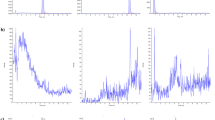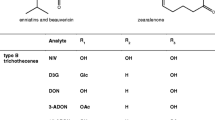Abstract
Cereal, fruit and vegetable products were analyzed for contamination with the Alternaria mycotoxins alternariol (AOH) and alternariol monomethyl ether (AME) using stable isotope dilution assays (SIDAs). Both toxins were practically not detected in cereals and cereal products: AOH—one out of 13 samples at a content of 4.1 μg/kg; AME—two out of 13 samples at contents ranging between 0.2 and 0.6 μg/kg. However, if cereals for animal nutrition were analyzed, much higher values were found: AOH—five out of six samples (13–250 μg/kg); AME—six out of six samples (3–100 μg/kg). This finding may pose a potential problem concerning animal health. AOH and AME were frequently detected in vegetable products: AOH—5 out of 10 samples (2.6–25 μg/kg); AME—6 out of 10 samples (0.1–5 μg/kg). Tomato products were affected, especially. The highest content of AOH (25 μg/kg) and AME (5 μg/kg) were found in triple concentrated tomato paste. Special wines like “Trockenbeerenauslese” or “Spätlese” (affected by noble rot in the vineyard) contained AOH (4/6 samples; 1.2–4.9 μg/kg) and AME (4/6 samples; 0.1–0.3 μg/kg), but the values did not exceed the values of both toxins that were found generally in wines.


Similar content being viewed by others
References
An YH, Zhao TZ, Miao J, Liu GT, Zheng YZ, Xu YM, Van Etten RL (1989) Isolation, identification, and mutagenicity of alternariol monomethyl ether. J Agric Food Chem 37(5):1341–1343
Andersen B, Frisvad JC (2004) Natural occurrence of fungi and fungal metabolites in moldy tomatoes. J Agric Food Chem 52(25):7507–7513
Asam S, Konitzer K, Schieberle P, Rychlik M (2009) Stable isotope dilution assays of alternariol and alternariol monomethyl ether in beverages. J Agric Food Chem 57(12):5152–5160
Azcarate MP, Patriarca A, Terminiello L, Fernández Pinto V (2008) Alternaria toxins in wheat during the 2004 to 2005 Argentinean harvest. J Food Prot 71(6):1262–1265
Bottalico A, Logrieco A (1998) Toxigenic Alternaria species of economic importance. In: Kaushal K, Bathnagar D (eds) Mycotoxins in agriculture and food safety. Marcel Dekker, New York, pp 65–108
Brugger EM, Wagner J, Schumacher DM, Koch K, Podlech J, Metzler M, Lehmann L (2006) Mutagenicity of the mycotoxin alternariol in cultured mammalian cells. Toxicol Lett 164(3):221–230
Da Motta S, Valente Soares LM (2001) Survey of Brazilian tomato products for alternariol, alternariol monomethyl ether, tenuazonic acid, and cyclopiazonic acid. Food Addit Contam 18(7):630–634
Fehr M, Pahlke G, Fritz J, Christensen MO, Boege F, Altemoeller M, Podlech J, Marko D (2009) Alternariol acts as a topoisomerase poison, preferentially affecting the IIα isoform. Mol Nutr Food Res 53(4):441–451
Hasan HAH (1995) Alternaria mycotoxins in black rot lesion of tomato fruit: conditions and regulation of their production. Mycopathologia 130(3):171–177
Lau BPY, Scott PM, Lewis DA, Kanhere SR, Cleroux C, Roscoe VA (2003) Liquid chromatography-mass spectrometry and liquid chromatography-tandem mass spectrometry of the Alternaria mycotoxins alternariol and alternariol monomethyl ether in fruit juices and beverages. J Chromatogr A 998(1–2):119–131
Li FQ, Yoshizawa T (2000) Alternaria mycotoxins in weathered wheat from China. J Agric Food Chem 48(7):2920–2924
Liu GT, Qian YZ, Zhang P, Dong WH, Qi YM, Guo HT (1992) Etiological role of Alternaria alternata in human esophageal cancer. Chin Med J 105(5):394–400
Magnani RF, De Souza GD, Rodrigues-Filho E (2007) Analysis of alternariol and alternariol monomethyl ether on flavedo and albedo tissues of tangerines (Citrus reticulata) with symptoms of Alternaria brown spot. J Agric Food Chem 55(13):4980–4986
Müller M, Waydbrink G, Peters M, Umann K, Seyfarth W (2002) Belastung von Winterweizen mit Alternaria-Mykotoxinen im Land Brandenburg. Mycotoxin Res 18(Suppl 2):217–220
Pero RW, Posner H, Blois M, Harvan D, Spalding JW (1973) Toxicity of metabolites produced by the Alternaria. Environ Health Perspect 4:87–94
Pfeiffer E, Eschbach S, Metzler M (2007) Alternaria toxins: DNA strand-breaking activity in mammalian cells in vitro. Mycotoxin Res 23(3):152–157
Schrader TJ, Cherry W, Soper K, Langlois I, Vijay HM (2001) Examination of Alternaria alternata mutagenicity and effects of nitrosylation using the Ames Salmonella test. Teratog Carcinog Mutagen 21(4):261–274
Scott PM, Lawrence GA, Lau BPY (2006) Analysis of wines, grape juices and cranberry juices for Alternaria toxins. Mycotoxin Res 22(2):142–147
Spanjer MC, Rensen PM, Scholten JM (2008) LC-MS/MS multimethod for mycotoxins after single extraction, with validation data for peanut, pistachio, wheat, maize, cornflakes, raisins and figs. Food Addit Contam 25(4):472–489
Stinson EE, Osman SF, Heisler EG, Siciliano J, Bills DD (1981) Mycotoxin production in whole tomatoes, apples, oranges, and lemons. J Agric Food Chem 29(4):790–792
Sulyok M, Krska R, Schuhmacher R (2007) A liquid chromatography/tandem mass spectrometric multi-mycotoxin method for the quantification of 87 analytes and its application to semi-quantitative screening of moldy food samples. Anal Bioanal Chem 389(5):1505–1523
Terminiello L, Patriarca A, Pose G, Fernandez Pinto V (2006) Occurrence of alternariol, alternariol monomethyl ether and tenuazonic acid in Argentinean tomato puree. Mycotoxin Res 22(4):236–240
Valero A, Marín S, Ramos AJ, Sanchis V (2008) Survey: ochratoxin A in European special wines. Food Chem 108(2):593–599
Author information
Authors and Affiliations
Corresponding author
Rights and permissions
About this article
Cite this article
Asam, S., Konitzer, K. & Rychlik, M. Precise determination of the Alternaria mycotoxins alternariol and alternariol monomethyl ether in cereal, fruit and vegetable products using stable isotope dilution assays. Mycotox Res 27, 23–28 (2011). https://doi.org/10.1007/s12550-010-0071-6
Received:
Revised:
Accepted:
Published:
Issue Date:
DOI: https://doi.org/10.1007/s12550-010-0071-6




